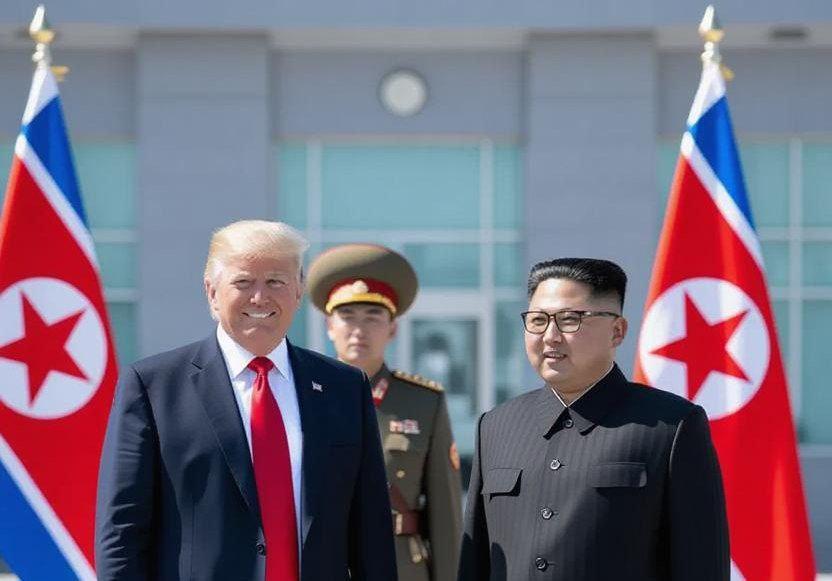
The Korean Peninsula has always been one of the most sensitive geopolitical flashpoints in the world, and once again, it finds itself in the global spotlight. While U.S. President Donald Trump has often made statements taking credit for international developments and projecting his leadership role in major global affairs, he had so far remained relatively quiet on the long-standing North Korea–South Korea dispute. That silence, however, was broken after the South Korean President’s recent visit to the United States, which triggered a fresh wave of comments and speculations surrounding North Korea.
Trump’s first presidential term was marked by fiery rhetoric and tense exchanges with North Korea’s Supreme Leader Kim Jong Un, including the infamous episode when Trump boasted about having a nuclear button on his desk, bigger and more powerful than Kim’s. That era of nuclear brinkmanship had left the world worried about a possible conflict. Now, in his second term, Trump once again finds North Korea at the center of political discourse—this time, in a more unconventional and surprising context.
During his meeting with Trump in the United States, the South Korean President openly appealed for a renewed push toward peace on the Korean Peninsula. Describing it as “the only remaining divided nation in the world,” he emphasized that the division continues to cause pain and suffering for humanity. In his remarks, he called upon Trump to take a decisive role in establishing peace by meeting with Kim Jong Un and exploring ways to normalize relations between the two Koreas.
But the highlight of the meeting came when the South Korean leader, speaking partly in jest, suggested that one day Trump could build a “Trump Tower” in North Korea and play a round of golf with Kim Jong Un himself. The comment, half in humor and half in diplomacy, sparked laughter from Trump, but also added a layer of intrigue. Was it simply a light-hearted moment, or a subtle signal that South Korea sees Trump’s personal ambition and charisma as tools that could be used to soften relations with North Korea?
The South Korean President expressed confidence that Kim Jong Un himself would be open to meeting Trump again. He noted that such an encounter could mark the beginning of a new era of trust on the Korean Peninsula, one that could reshape not only inter-Korean ties but also the broader regional security environment. The idea of Trump being seen not only as a global statesman but also as a personality capable of building bridges—even in hostile territory—was underscored during this meeting.
This development comes at a delicate time. North Korea has been ramping up its missile testing and nuclear program in recent months, drawing sharp criticism from the international community. At the same time, the United States and its allies remain focused on broader security challenges, particularly the escalating tensions with Russia and Iran. While Trump’s administration is tightening pressure on Moscow and Tehran, the Korean Peninsula has not been at the top of Washington’s strategic agenda.
Analysts point out that this balancing act could prove complicated. With America’s attention drawn heavily toward Russia’s geopolitical maneuvers and Iran’s aggressive posture, the U.S. risks losing direct influence over South Korea’s independent strategies in dealing with its northern neighbor. Already, signs are emerging that South Korea is exploring diplomatic flexibility beyond the U.S. framework, which could alter the dynamics of the region.
For Trump, the South Korean President’s playful yet pointed remarks present both an opportunity and a challenge. On one hand, it opens the door for him to re-engage with North Korea, a country where his earlier diplomatic overtures—such as the historic 2018 Singapore Summit with Kim Jong Un—brought him global attention, even if the results fell short of lasting peace. On the other hand, taking up such a role now would require balancing it against the backdrop of escalating conflicts with Russia and Iran, where American strategic interests are deeply entangled.
Whether the vision of a Trump Tower in Pyongyang and a golf match between Trump and Kim ever materializes remains doubtful, but the symbolism behind the remark cannot be dismissed. It underscores how South Korea sees Trump’s personality-driven diplomacy as a possible catalyst for peace. More importantly, it reflects the urgency felt by Seoul, which continues to live under the constant shadow of North Korea’s missile threats.
In the end, the world now watches closely. Will Trump once again step into the arena of North Korea diplomacy, this time with a mix of seriousness and showmanship? Or will the Korean Peninsula remain overshadowed by America’s confrontations with Russia and Iran?
For now, one thing is clear: the South Korean President’s lighthearted suggestion has reopened conversations about peace, trust, and the role of Trump in shaping the future of one of the world’s most volatile regions.




